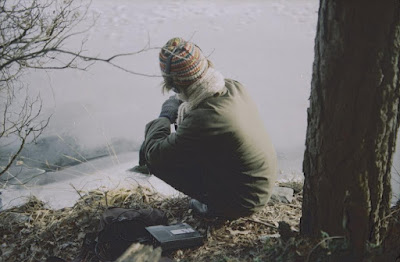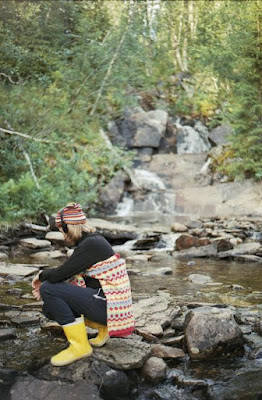Olli Aarni
“A byproduct of being outdoors, being still and listening”
With Vesiä, 29 year old Finnish artist and musician Olli Aarni made a triple tape box set with recordings of water.
What does Vesiä mean?
Vesiä means Waters in Finnish. I wanted to keep it really simple and self-explanatory. I almost always use the Finnish language on the titles of my work, because I’m bored of English most often being the lingua franca for art.
Are the titles of the tracks the names of the places where you made the recordings?
Yes they are. Unfortunately some of them are less precise than others. For example, the lake Seljänalanen is way more specific than the Lofoten archipelago. I just wasn’t sure of the names of the specific locations there so I had to play it safe.
Is the Vesiä tape: six recordings of water? Why did you want to record water?
That’s exactly what it is. It came quite naturally, because I like being in the nature and recording waters is just a byproduct of being outdoors, being still and listening.
Usually I have a more creative role in my music, but here I just set the parameters and let everything happen on it’s own. I chose the equipment, time and place but I didn’t interfere with any of the sounds happening. There are endless streams of sounds like these happening all the time. I’ve been interested in different sorts of generative music, and to me this release is essentially part of that continuum: I don’t feel like the sounds here are linear as much as they are generative, and my own role is reduced to just setting the premises. Some of the sounds presented here maybe took place for just a brief moment, but others may have spread over a really long period of time.
I also like the treasure hunting aspect of making recordings out in the nature.
Did you know what you wanted to record before you pressed ‘record’?
Not really. I guess I’m mostly interested in recording flowing water, because it often sounds sounds so vivid and some kind of results are pretty much granted. Still water can be really quiet sometimes. Half of the pieces on this release are of a lake, the other half consists of recordings of streams and waves.
Did you go to these places with the specific goal to make a recording?
I’ve made almost all of these recordings while travelling with my partner or just being outdoors with her. She likes to photograph and I like to record things, and both of those activities influence where we’ve been going. We went to Lofoten mostly because of the views and the beautiful nature, and I wasn’t that aware of all the cool little mountain streams beforehand.
How do see this album yourself? As a concept album or as a field recording album?
To me it’s a field recording album. It’s also a memory of the times I’ve spent out in the nature last year. I haven’t stopped recording water sounds, so I see this as a document of an ongoing practice.
Were the recordings of rivers by Chris Watson an influence on these recordings?
Not really, I hadn’t heard them before. I’ve enjoyed some of his other recordings though, like the Oceanus Pacificus 7”, and Ande Somby’s Yoiking with the Winged Ones LP.
You mention the type of tape recorder and microphones you used. Is this important to you? Why did you want to record on tape (and not digitally)? Are the microphones waterproof?
I wanted to mention that because I wanted everything to be as transparent as possible. Somehow it just feels important to focus on something as insignificant as documenting vibrations in water. I’m not sure if I really want to communicate anything with these recordings though. They’re made out of fascination towards all the endless generative processes around us. Water is a pretty easy access point for observing some of them.
I like recording to tapes because they are physical objects which you alter while recording to them. I’ve used old cassettes from thrift stores and flea markets for these recordings. It’s like writing a new chapter to a life story of these funny little plastic objects. Now they’re sitting in a shoe box that is my personal archive.
I used D-series hydrophones by Jez Riley French for these recordings. They’re 100 % waterproof and all of the sounds on these recordings occurred underwater.
The Bandcamp page mentions ‘no editing’. Why no editing?
I wanted to mention it to underline that there’s not that much artistic intention in the sounds. I don’t feel like editing would add anything to the sounds, probably they’d be more boring were they forced into some culturally agreed standard.
Why did you release these tapes as a triple tape box set?
I wanted to make the transitions in time and space clear. The listener has to turn the tape after each recording, and this way the recordings don’t create so strong continuum. The choice of format also allows different sequencing and transitions between the tracks.
Why did you self-release this record? Why a limited edition of 40?
I stumbled upon this batch of unused hi-quality c10 tapes, so it all happened quite naturally. I made as many sets of 3 tapes I could get out of them. I had a pretty clear vision of how I wanted to make this release so I thought I’d just do it myself.
All photos © Mia Tarkela
– Joeri Bruyninckx
© Copyright http://www.psychedelicbabymag.com/2017
Array








